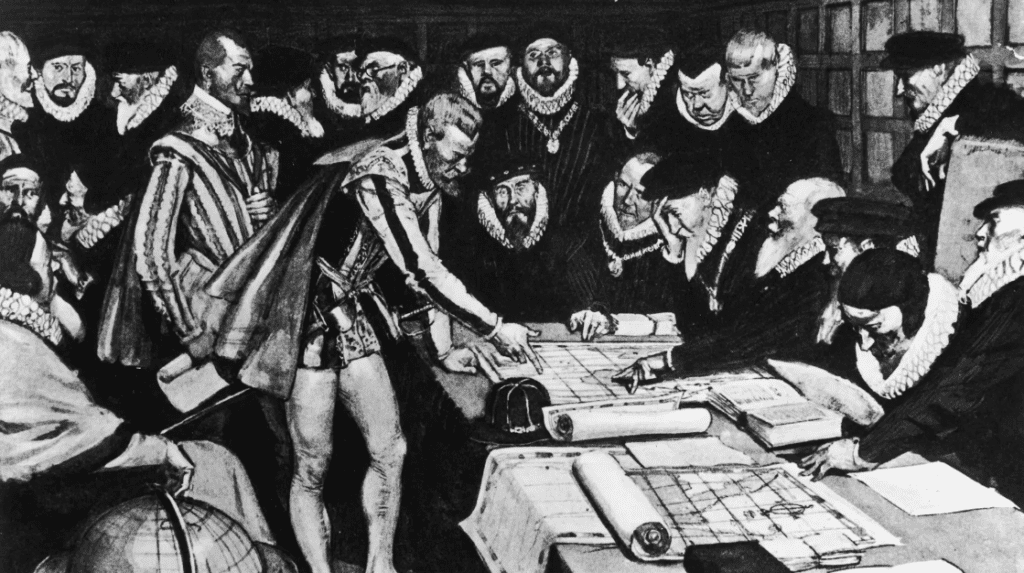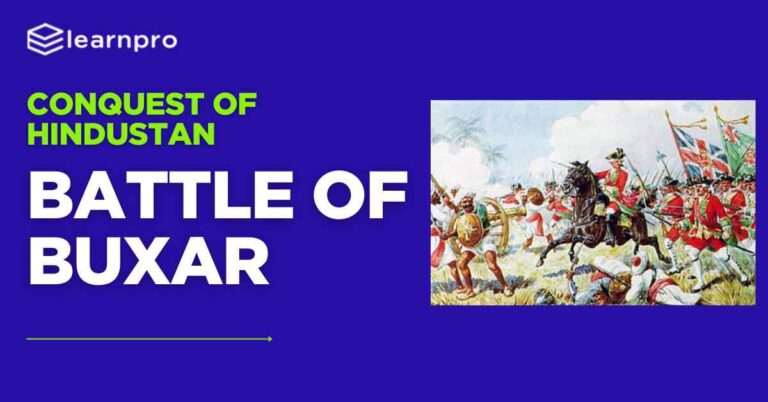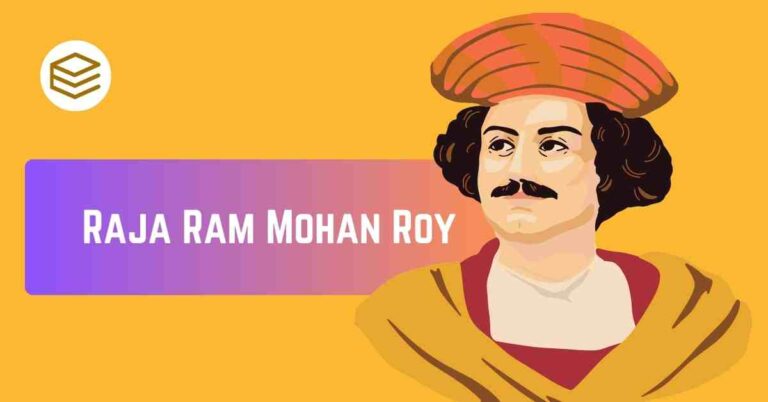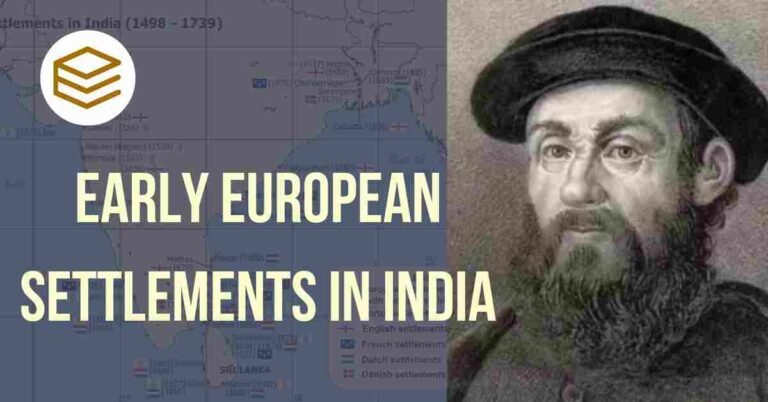October 25, 2025 5:37 pm
The Dutch , English and French
Table of Contents
- The Dutch in India
- The English and the French East India Companies
- The English East India Company in India: Expansion and Consolidation
- Charter of Queen Elizabeth I and Early Ventures:
- Establishing a Foothold in the West and South
- Expansion and the Establishment of Bombay as a Key Centre
- Building Fort St. George in Madras
- Expansion into Bengal and Consolidation of Power
- Farrukhsiyar’s Farmans
- The French in India
- Pondicherry—Nerve Centre of French Power in India:
- Early Setbacks to the French East India Company:
- Reorganisation of the French Company
- The English East India Company in India: Expansion and Consolidation
The Dutch in India

- The Dutch East India Company, or Vereenigde Oostindische Compagnie (VOC), was established in 1602. Its formation marked a significant shift in European trade strategies, as the Dutch government granted the VOC extensive powers, including the right to wage war and govern territories. This was revolutionary for its time, as the VOC became the first multinational corporation with its own army and navy.
- The Dutch East India Company’s ventures into India were primarily driven by the pursuit of commercial opportunities. In 1602, the States General of the Netherlands consolidated various Dutch trading companies into a single, powerful entity known as the Dutch East India Company (VOC). This company was granted far-reaching powers, including the right to wage war, negotiate treaties, acquire territory, and construct fortresses.
- When the Dutch arrived in India, they quickly established their first factory in Masulipatnam (located in present-day Andhra Pradesh) in 1605. This marked the beginning of their expansion across India, which eventually posed a significant threat to the Portuguese, who had long dominated the region’s trade. The Dutch strategically expanded their presence, capturing key locations, including Nagapatam near Madras (now Chennai), which became their primary stronghold in South India.
- The Dutch capitalized on India’s rich resources, exporting a variety of valuable goods. They traded indigo from the Yamuna Valley and Central India, as well as textiles and silk from Bengal, Gujarat, and the Coromandel Coast. Additionally, they exported saltpetre from Bihar and opium and rice from the Ganga Valley, establishing a strong trading network that supplied lucrative markets in Europe and Southeast Asia.
Anglo-Dutch Rivalry:
- The English were also at this time rising to prominence in the Eastern trade, and this posed a serious challenge to the commercial interests of the Dutch. Commercial rivalry soon turned into bloody warfare.
- The climax of the enmity between the Dutch and the English in the East was reached at Amboyna (a place in present-day Indonesia, which the Dutch had captured from the Portuguese in 1605) where they massacred ten Englishmen and nine Japanese in 1623.
- This incident further intensified the rivalry between the two European companies. After prolonged warfare, both the parties came to a compromise in 1667 by which the British agreed to withdraw all their claims on Indonesia, and the Dutch retired from India to concentrate on their more profitable trade in Indonesia.
Decline of the Dutch in India
- As the Dutch East India Company (VOC) expanded its operations, its primary focus increasingly shifted toward the profitable trade routes of the Malay Archipelago. The region, known for its rich resources of spices like nutmeg, cloves, and mace, was far more lucrative for the Dutch compared to their ventures in India. Consequently, the Dutch prioritized securing and maintaining their dominance in the Spice Islands (modern-day Indonesia) over expanding territorial control in India.
- This strategic focus contributed to a gradual decline in their presence on the Indian subcontinent. The pivotal Battle of Bedara in November 1759 marked a decisive moment in this process. In this conflict, British forces decisively defeated the Dutch, effectively ending any remaining Dutch ambitions in India. The battle underscored the VOC’s limited interest in empire building in India, as they had long been more concerned with maintaining profitable trade networks rather than establishing a colonial empire.
- The VOC’s primary objective remained the trade of valuable spices from the Indonesian islands, which offered enormous profits and shaped their overall strategy in the region. As a result, while they played a significant role in Indian trade, the Dutch did not seek to exert substantial political or military control over Indian territories, instead focusing on areas where their commercial interests aligned more closely with their strategic priorities.
The English and the French East India Companies

The English East India Company in India: Expansion and Consolidation
Charter of Queen Elizabeth I and Early Ventures:

The foundation of the English East India Company can be traced back to a period of heightened British maritime ambition. In 1580, Francis Drake completed his voyage around the world, followed by the English victory over the Spanish Armada in 1588, which inspired a new sense of enterprise. With increased awareness of the wealth accumulated by the Portuguese from Eastern trade, English merchants were eager to participate.
- Formation of the Company (1600): On December 31, 1600, Queen Elizabeth I issued a royal charter establishing the ‘Governor and Company of Merchants of London trading into the East Indies.’ Initially granted a fifteen-year monopoly on Eastern trade, this charter was later extended indefinitely in 1609. The Dutch were already well-established in the East Indies, so the English turned their sights towards India.
Establishing a Foothold in the West and South

- Captain Hawkins and Early Struggles (1609-1611): Captain William Hawkins arrived at the Mughal court of Emperor Jahangir in 1609 but failed to secure a trading post at Surat due to Portuguese opposition. However, by 1611, the English had begun trading at Masulipatnam on India’s southeastern coast.
- Victory at Surat (1612): In a naval battle off Surat, Captain Thomas Best defeated the Portuguese, impressing Jahangir and securing permission for a factory at Surat in 1613. This marked the first significant English trading post in India.
- Sir Thomas Roe’s Mission (1615-1619): As an ambassador from James I, Roe secured trading privileges from Jahangir, allowing the English to set up additional factories in Agra, Ahmedabad, and Broach. Though he couldn’t establish a formal treaty, these permissions laid the foundation for expanding the Company’s operations.
Despite initial resistance, the English gradually built a network of trading posts along India’s coastlines.
Expansion and the Establishment of Bombay as a Key Centre
The English faced competition not only from the Portuguese but also from the Dutch, who were deeply entrenched in the region.
- Acquisition of Bombay (1662): Bombay was gifted to King Charles II as part of the dowry when he married Catherine of Braganza, a Portuguese princess. In 1668, the English East India Company leased Bombay from the crown for a nominal annual fee. By 1687, they shifted the Western Presidency’s headquarters from Surat to Bombay, solidifying it as their primary base in Western India.
- Anglo-Dutch and Anglo-Portuguese Agreements: Over time, a compromise with the Dutch and peaceful relations with the Portuguese allowed the English to focus on expanding their trade. The Golden Farman of 1632 from the Sultan of Golconda granted the Company trading rights in the Golconda region, enhancing their operations.
Building Fort St. George in Madras
As the Company continued its expansion, they also sought to establish fortified trading settlements for protection and control.

- Founding of Madras (1639): In 1639, English merchant Francis Day received permission from the ruler of Chandragiri to build a fortified factory at Madras. This became Fort St. George, which later replaced Masulipatnam as the English headquarters in southern India. It grew into a significant hub for trade and administration.
Expansion into Bengal and Consolidation of Power
The fertile and economically vital province of Bengal attracted the Company’s interest. They sought to secure a foothold in this wealthy region.
- Initial Expansion (1651): Shah Shuja, the Subahdar of Bengal, granted the Company permission to trade in Bengal for an annual fee of 3,000 rupees. They established factories in Hooghly, Kasimbazar, Patna, and Rajmahal.
- Conflict and Consolidation (1682-1690): After customs officials hindered their operations, the Company sought to fortify Hooghly. When the Mughal governor refused, hostilities erupted. Although the English were initially driven out, Job Charnock, a Company agent, negotiated their return in 1690, leading to the establishment of a factory at Sutanuti (later Calcutta). By 1691, they secured permission to trade freely in Bengal for an annual fee of 3,000 rupees.
- Fortification of Calcutta (1696): Taking advantage of a local rebellion, the English fortified their settlement, establishing Fort William in 1700. This became the administrative center of the Company’s operations in Eastern India, with Sir Charles Eyre as its first president.

The English East India Company’s gradual expansion in India laid the foundation for a formidable commercial empire. They systematically built relationships with local rulers, acquired strategic territories, and established fortified settlements to secure their trade and influence. Over time, their increasing economic and political power would allow them to challenge other European powers and establish a colonial empire that would dominate India for centuries.
Farrukhsiyar’s Farmans
In 1717, the English East India Company secured three pivotal farmans from Mughal Emperor Farrukhsiyar, following a mission led by John Surman. These farmans, considered the Magna Carta of the Company, granted the English significant privileges in key regions like Bengal, Gujarat, and Hyderabad.
Key Provisions of the Farmans:

- Exemption from Customs Duties in Bengal: The Company’s imports and exports were exempt from additional customs duties, except for an annual payment of 3,000 rupees.
- Issuance of Dastaks: The Company was allowed to issue dastaks (passes) for transporting goods, easing their trade operations.
- Permission to Acquire Land Around Calcutta: The Company could rent additional land around Calcutta, facilitating the expansion of their operations.
- Freedom from Duties in Hyderabad: The Company retained freedom from trade duties, with an obligation to pay the prevailing rent only for Madras.
- Duty Exemption in Surat: For an annual fee of 10,000 rupees, the Company was exempted from all trade duties.
- Company Coins as Legal Tender: The Company’s coins minted in Bombay were to be accepted throughout the Mughal empire, bolstering their economic influence.
Through strategic diplomacy, the English East India Company leveraged these farmans to secure vital trading advantages. However, to fully dominate the Indian trade landscape, they first needed to overcome competition from the French, which would later result in significant conflicts between the two European powers.
The French in India
- The French were the last Europeans to come to India with the purpose of trade.
- During the reign of Louis XIV, the king’s famous minister Colbert laid the foundation of the Compagnie des Indes Orientales (French East India Company) in 1664, in which the king also took a deep interest.

- The Company was granted a 50-year monopoly on French trade in the Indian and Pacific Oceans. The French king also granted the company a concession in perpetuity for the island of Madagascar, as well as any other territories it could conquer.
- The Company spent a lot of its money and resources in trying to revive the colonies of Madagascar but without any success. Then in 1667, Francois Caron headed an expedition to India, setting up a factory in Surat.
- Mercara, a Persian who accompanied Caron, founded another French factory in Masulipatnam in 1669 after obtaining a patent from the Sultan of Golconda.
- In 1673, the French obtained permission from Shaista Khan, the Mughal Subahdar of Bengal, to establish a township at Chandernagore near Calcutta.
Pondicherry—Nerve Centre of French Power in India:

- In 1673, Sher Khan Lodi, the governor of Valikondapuram (under the Bijapur Sultan), granted the French, a site for a settlement. Pondicherry was founded in 1674.
- The French company established its factories in other parts of India also, particularly in the coastal regions. Mahe, Karaikal, Balasore and Qasim Bazar were a few important trading centres of the French East India Company.
- After taking charge of Pondicherry in 1674, Francois Martin developed it as a place of importance. It was indeed, the stronghold of the French in India.
Early Setbacks to the French East India Company:
- The French position in India was badly affected with the outbreak of war between the Dutch and the French.
- Bolstered by their alliance with the English since the Revolution of 1688, the Dutch captured Pondicherry in 1693. Although the Treaty of Ryswick concluded in September 1697 restored Pondicherry to the French.
- Once again, under Francois Martin’s able guidance Pondicherry flourished and turned out to be the most important settlement of the French in India.
- Again there was a bad turn in the fortunes of the French company in India when the War of Spanish Succession broke out in Europe.
- Consequent to this, they had to abandon their factories at Surat, Masulipatnam and Bantam in the early 18th century.
- The French in India had another setback when Francois Martin died on December 31, 1706.
Reorganisation of the French Company
- In 1720, the French company was reorganised as the ‘Perpetual Company of the Indies’ which revived its strength.
- Further, the French India was backed by the French possession of Mauritius and Reunion in the southern Indian Ocean.





